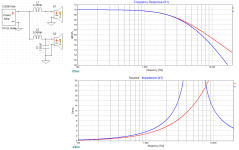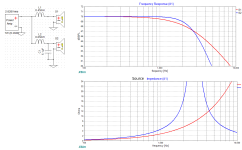The spheres are 3D printed from red PLA. They produce an in the room performance effect that makes my other speakers seem boring. If you ever have any interest in building some send me a message and I can help. The spheres work from 300Hz and up. Your speakers look great. The plexi amplifier case is amazing. It is great to be able to see all the components and wiring after you put so much time into it.Oslond3, I love them! You have spheres! That's spectacular! What's the material? How did you make them? Either way, super cool.
Here's the desktop computer speakers I finished last week (with KABD-430 and the little plexiglass box I made for it). Still tweaking FR with the DSP and I'm obviously not done with the cabinets (paint, and I'll be sticking a .25 inch felt sheet into the front baffle). No one will ever accuse me of making pretty speakers. 😆 The SPL graphs aren't obscene but still need dialing in. Can you tell I live in a concrete box? LOL
https://www.minidsp.com/products/minidsp-in-a-box/flexIMO, DSP has huge limitation in terms of tinkering with amps, preamps and dac's.
I have no doubt that it really works well when done properly, but one will loose flexibility in system other than loudspeakers.
Compromises, again...
With the digital I/O version of the miniDSP FLEX you can connect any DAC and amplifiers you want to use and swap them at will. If you still want to play your old records, a preamp with an A/D built in will do the job. There are high end digitizing phono preamps that even remove pops and clicks as well. No compromises required. https://www.theabsolutesound.com/articles/ps-audio-nuwave-phono-converter/ So roll tubes in your SET amps and hookup that $45,000 DAC of the month.
We're talking about two different things here. It's one thing to swamp impedance nonlinearities. It's another to allow distortion to happen and to curtail the realisation of the harmonics.The series notch filter is raising the drive impedance. It has been demonstrated that high output impedance amplifiers can reduce the distortion.
Analogue active filters would be my pick. The downside (or is it?) is that it's a bit less plug and play -- if you want adjustability you have to BYO potentiometers onto a custom PCB basically. But it's not a total jungle and there are a few kits floating around.
I assume you'd want to keep the tube amp for the tweeter and mid, so it would probably benefit if the bass is already filtered out from the input. Whether it's analogue active or DSP probably doesn't matter if comparing good quality on both sides.
There are also benefits to filtering woofers passively with a 1st order inductor based filter. It blocks distortion caused by the speaker's non-linear inductance and could increase the usable frequency range, which is difficult to achieve in an active-only system unless you go down the road of an esoteric amplifier with current drive or mixed-mode feedback. The shunt capacitors in higher order passive filters are likely to mess things up anyway, so the best of both worlds would be to stay with a modest 6dB/octave air-cored inductor, and do most of the filtering at the amplifier input.
I assume you'd want to keep the tube amp for the tweeter and mid, so it would probably benefit if the bass is already filtered out from the input. Whether it's analogue active or DSP probably doesn't matter if comparing good quality on both sides.
There are also benefits to filtering woofers passively with a 1st order inductor based filter. It blocks distortion caused by the speaker's non-linear inductance and could increase the usable frequency range, which is difficult to achieve in an active-only system unless you go down the road of an esoteric amplifier with current drive or mixed-mode feedback. The shunt capacitors in higher order passive filters are likely to mess things up anyway, so the best of both worlds would be to stay with a modest 6dB/octave air-cored inductor, and do most of the filtering at the amplifier input.
They won't, they actually tend to increase the source impedance even though they don't intuitively appear that way..The shunt capacitors in higher order passive filters are likely to mess things up anyway,
https://www.diyaudio.com/community/threads/the-elsinore-project-thread.97043/post-7316916


P.s. I just read a new Mini DSP is around the corner: the Flex HTx. Looks very interesting. 8 channel Balanced out. Good datasheet figures. Could be used both as DSP processor for stereo input and as a 8 channel DAC for PC.I would vote for Hypex Fusion as well. I use the 253. It has a very good price performance ratio and can give good results. Alternatively you could also look into MiniDSP Flex 8 HT (with separate amps). My understanding is that version also allows PC DSP processing as it can do 8 in. Nice to keep options open. In case you anyhow want to do PC processing, you could look into OktoDAC 8 PRO.
Over time, I would want to move to an even more high end platform, but it appears to be hard to find something much better than Fusion system without spending crazy amounts of money...
https://www.minidsp.com/products/ht-series/flex-htx
The shunt capacitors in higher order passive filters are likely to mess things up anyway,
--------------------------------------------------------------------------------------------------------------------------------They won't, they actually tend to increase the source impedance even though they don't intuitively appear that way..
It's called Reactance and is inexorably linked to phase shift.
Digital filters can create the same 'curve' without phase shift.
Last edited by a moderator:
We're talking about the way that the driver's source impedance reduces harmonic distortion. Passive filters can reduce that distortion. Current amplifiers too as they add impedance in effect between the amp and speaker.
There is a myriad of things digital can do that analog simply can't,There are high end digitizing phono preamps that even remove pops and clicks as well.
including all the measurement/simulation programs people are using.
Please remember, I am also a part of "WE".
The statement I made is correct.
The TOPIC is > DSP vs Passive.
The statement I made is correct.
The TOPIC is > DSP vs Passive.
Yes, you are absolutely right. This would require a slight change in the design approach. For instance,They won't, they actually tend to increase the source impedance even though they don't intuitively appear that way..
https://www.diyaudio.com/community/threads/the-elsinore-project-thread.97043/post-7316916
View attachment 1250416View attachment 1250417
1) start by assessing the subjective harshness of the raw driver output to determine the break-up band.
2) apply a resonant LC filter to cover that band.
3) tweak the resulting filter actively to get the desired slopes and cut-off points.
A caveat could be that the driver still has high sensitivity above that 4kHz or 8kHz mark in the examples, but those issues would likely come out in the wash, if the development effort is put in.
A notch filter would potentially improve the situation. The example only covered the capacitor question.
Another thing rarely mentioned is that at angles where breakup already lowers response, distortion would be less.
Most times breakup is discussed in these terms it is about increasing distortion, but it can go the other way. The breakup effect is only about suppresing harmonics, not reducing distortion production per se. Nowhere does breakup usually peak as it does on axis, and many don't listen at 0 degrees to begin with. When 0 degrees is only considered in terms of it's power contribution, it's relatively insignificant.
Another thing rarely mentioned is that at angles where breakup already lowers response, distortion would be less.
Most times breakup is discussed in these terms it is about increasing distortion, but it can go the other way. The breakup effect is only about suppresing harmonics, not reducing distortion production per se. Nowhere does breakup usually peak as it does on axis, and many don't listen at 0 degrees to begin with. When 0 degrees is only considered in terms of it's power contribution, it's relatively insignificant.
But isn't it already a notch in terms of the impedance seen by the speaker? When considering supplementing the filter slopes actively, the passive filter response is basically "don't care". Within reason. In principle, we could create a huge hole in the response, requiring several dB of active boost, which would then have to be weighed up against possible amplifier distortion.
All of these factors have to be weighed up, and put against their audibility. I'm not implying that it's a problem.
The thing with the breakup issue is that input filters don't work in reverse. When the driver produces the distortion, the harmonic within the stopband is potentially produced at the unfiltered level, which is additionally often higher even than the passband if you focus on the 0 degree axis at breakup.. not that you should.
This is why Dr Geddes at one time experimented with bandpass boxes. It would have been before his distortion studies. The bandpass boxes acoustically filter the harmonics.
I hope I'm understanding your question?
The thing with the breakup issue is that input filters don't work in reverse. When the driver produces the distortion, the harmonic within the stopband is potentially produced at the unfiltered level, which is additionally often higher even than the passband if you focus on the 0 degree axis at breakup.. not that you should.
This is why Dr Geddes at one time experimented with bandpass boxes. It would have been before his distortion studies. The bandpass boxes acoustically filter the harmonics.
I hope I'm understanding your question?
Now THAT is the product I have been waiting for... I have wanted to do a 4-way active system for some time...P.s. I just read a new Mini DSP is around the corner: the Flex HTx.
Now THAT is the product I have been waiting for... I have wanted to do a 4-way active system for some time...
Check it again: it is heavily aimed at multi-channel setup rather than multi-way stereo. No general input PEQ , output PEQ IIR only , no FIR available except for multi-channel Dirac.
Me too.Now THAT is the product I have been waiting for... I have wanted to do a 4-way active system for some time...
First point of business would be to find a 3/4" hard dome tweeter or a ribbon tweeter.
I read somewhere that MiniDSP is considering to add input PEQ in a software update. But indeed, it would be good that MiniDSP updates their SHARC platform to something newer for future HW. 48 kHz is also a bit of a low processing sampling rate...
Thanks for the link to these! Awesome project!Hi tktran. You can find my posts in the "How to build spherical speakers" https://www.diyaudio.com/community/threads/how-to-build-a-spherical-speaker.374278/page-23 I have pictures of my first version there 6" diameter with 20 drivers. Seeking to reduce the size the new version 4" diameter. I will have to create a new thread to document the new design. The DSP is very helpful to correct response in the high frequencies. The directivity plot is amazing. I need to work on improving the range above 4 kHz.

- Home
- Loudspeakers
- Multi-Way
- decision fork: DSP vs passive?